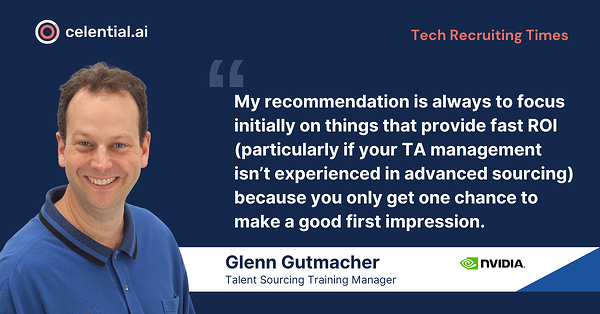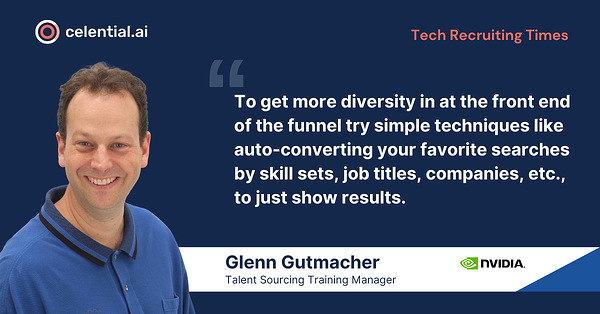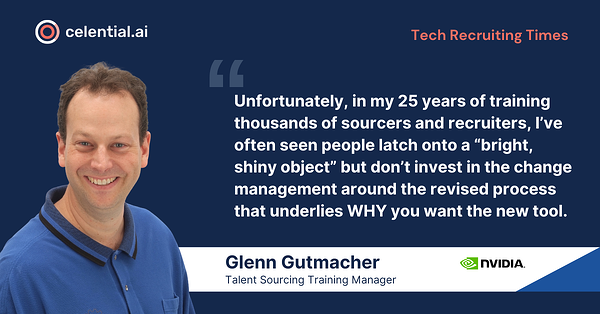A new technological revolution is upon us: transportation is going electric, energy production is shifting to renewables, AI is already here and Web3 is coming sooner than most people think.
It is a turning point for talent acquisition with new specializations popping up each year and an ever-increasing skills gap. Companies can only move forward based on the merits of their tech talent and technical recruiters are the only people who can help find them.
That is why we created the Tech Recruiting Times. We wanted to fill the gap of content for tech recruiters and engineering leaders and help prepare the people on the front lines of these changes.
Every two weeks we will offer advice, opinions, and breaking news through interviews with the industry’s leading professionals.
We hope you enjoy this week’s issue!
This week’s topic
How can recruiters utilize automation rather than be replaced by it? Here are the specific components you need to upskill your sourcing team to the next generation.

This week’s guest: Glenn Gutmacher

For our first edition, we sat down with Glenn Gutmacher. Currently the Talent Sourcing Training Mgr. at NVIDIA, Glenn has managed US and offshore diversity sourcing teams at multi-billion-revenue firms like Microsoft and Avanade and trained recruiters from hundreds of companies from the Fortune 500 to small staffing firms. He’s the co-founder of the Boston Area Talent Sourcing Association (BATSA) and DEI Cohort. A Yale University graduate, Glenn has been pioneering recruiting tech since the 1990s.
He joined with New England’s largest newspaper chain to found the award-winning JobSmart website in 1996 (which beat out the Washington Post’s Careers page in 1998 for the industry’s two most prestigious awards (the EpPY and Digital Edge Awards). He also created Recruiting-Online.com, an Internet recruiting seminar that was one of the first self-paced, fully-online talent sourcing courses.
We were excited to hear how Glenn leverages new tech to develop innovative recruiting strategies and tools in scalable, cost-effective ways.
1. What are the critical soft skills of technical sourcers that will make them indispensable (and not AI-replaceable)?
All great technical sourcers have at least four traits: curiosity, diligence, business acumen, and empathy.
Curiosity means they’re not satisfied with what they read in a job description or a resume. They want to learn more and (along with trait #2 diligence) will dig to find out — by asking questions of people (internally and externally) who are familiar with the type of candidate needed, doing research with GlossaryTech, Wikipedia. etc.
Those help them achieve trait #3 (business acumen): Once they understand the context of the role and team beyond the keywords, they can read between the lines when they see a profile or resume and know what areas to probe when speaking to prospects to separate the wheat from the chaff.
Hiring managers appreciate these three traits of technical sourcers, too, because they’re saving them time from not having to speak with marginal candidates who can talk the talk but not walk the walk.

They come to trust their technical sourcer and their recommendations more and the whole candidate journey (and also time-to-qualified slate) moves faster.
Empathy is key because you can appreciate the triggers (for both candidate and the hiring team) and build rapport. You can tailor the discussions to address concerns and smooth the way to advancing to the next stage.
Or, you might mutually determine the current role isn’t the best fit, but learn enough in the process to steer them for a better match.
It’s a bonus if you have a data science/talent intelligence inclination, meaning you like utilizing the stats around the job market.
With these stats, you can act as a talent advisor to hiring managers who insist on a candidate that ticks all the boxes but your research shows there are only 10 of them in the world and being paid FAANG level (or already working for one of them!).
So you’d be smarter to compromise on some must-haves and nice-to-haves that they can learn on the job in a couple of months rather than let the job remain unfilled even longer.
You can explain even if you got lucky hiring someone after that point, you’d be paying them above market rate to poach them AND the retention level will likely be lower because they’d say “been there, done that” for the job duties.
2. Sourcing automation has already revolutionized how sourcers find candidates at scale and also conduct outreach. What are some examples of what you use?
Some things are simple, effective and already widely used because they bear no additional cost, like saving multiple email signatures in Microsoft Outlook with templates covering 90% of the types of communication you have with colleagues and candidates.
That way, only minimal individual customization is necessary for each new or reply message.
Or, save hours per week with a free self-scheduling tool like Calendly or Microsoft Bookings to eliminate back-and-forth time on setting up individual/group interviews and meetings with internal and external invitees.
if you’re on the web, hopefully, you use free Chrome extensions like Magical, which populate common message screens on LinkedIn and other web forms with recipient-customized responses; or OneTab which allow sourcers to consolidate all the inevitably many open browser tabs into one linked page that you can revisit anytime or share with a colleague.

Conversely, you can use something like Link Clump or Open Multiple URLs to quickly open a bunch of links in their own tabs to process the data better for web scraping, etc.
Speaking of web scraping, there are so many options for this, and some of the best ones are free: Instant Data Scraper is the easiest but it doesn’t work on all websites. A more flexible tool is Webscraper.io but it has a higher technical learning curve.
Something in the middle that’s also popular with sourcers like Data Miner might be better, but limits you to 500 pages per month free, then you need to upgrade to a paid license.
3. Why is it so important to have systems/processes for your sourcing strategies? Are there different tiers to the options of tools that you can choose from?
There are many tiers of tool complexity and cost. Unfortunately, some that would add tremendous ROI to every sourcer and recruiter on the team are bypassed by many organizations due to the high barrier to entry (the upfront cost of licenses and/or implementation).

My recommendation is always to focus initially on things that provide fast ROI (particularly if your TA management isn’t experienced in advanced sourcing) because you only get one chance to make a good first impression.
And make sure you measure everything starting at base state so the metrics you can present later for improved quality, time, cost, etc., are clear.
Once they see the value, then you’re in a great position to make the business case to ramp it up further (even if there’s a cost).
But even on the big-ticket items, if you can get your CHRO to see the forest through the trees, they’d realize the time saved once most individual contributors are up to speed matters.
If you take the difference in time to whatever metric — first screen/submit after intake, first offer or hire, or diverse candidate slate on a requisition or pipeline — and multiply it by the number handled per TA staffer, you’ll see the tech more than pays for itself (usually in months, not years, depending on your team size)!
4. What tips or software recommendations could you pass on right now to help address the challenge of diversity in the software industry?
First, avoid language like “diverse software persons” or generalizations for metrics.
As an external TA colleague, Precious Lesley, recently said: “Diversity hiring metrics is an acceptable term: those metrics measure the diversity of the candidates hired by an organization and help identify issues in this area.
But don’t label a human a “diversity hire”.
This is: A) not an accurate use of the term as all humans are part of diversity, but you’d never use the term to describe white, straight, cis-gendered, able-bodied, neurotypical candidates; and B) a form of tokenism that has been proven to not work and goes against the intended goal.
That being said, companies have seen success by such tactics as “blinding” prospects or interviewees.
Many search tools will insert a cat or dog face instead of the person’s name and remove other identifying information automatically, so as not to bias anyone starting from the sourcing stage through the first interview. Otherwise, you can inadvertently filter out promising talent.
Is there really a reason to see someone’s name, location or face at the first evaluation stage? Or is someone who’s disabled really unable to do the job if you put modest accommodations in place (which are probably legally required, anyway)?
I’d much rather allow that visual ID to happen once a decision-maker has made an affirmative call to progress to the next evaluation stage and more eyes are on the process so if that underrepresented talent falls out of the process, managers will notice and ask why.

Conversely, there are many companies where unconscious bias is a less significant problem and they just want help to get more diversity in at the front end of the funnel.
In those situations, I recommend simple techniques like auto-converting your favorite searches by skill sets, job titles, companies, etc., to just face results (e.g., see my bookmarklets page for some free tools).
5. What solutions or strategies do you see key in fostering the transition to more in-depth passive sourcing for tech talent?
As I mentioned before, I think the game-changer technologies tend to be bypassed because of enterprise cost or complexity, but in the end, they should be simple for individual TA end-users to incorporate into their daily work, and thus have high ROI.
Solutions such as a recruiting CRM to house pre-applicant prospects and automatically keep them warm with relevant messaging, or an assessment platform (both for video and virtual reality soft skills as well as hard skills tech testing) can be huge boons for TA organizations — when implemented well.

Unfortunately, in my 25 years of training thousands of sourcers and recruiters, I’ve often seen people latch onto a “bright, shiny object” (as my former Microsoft boss Rob McIntosh explained it in this 2008 recruiting blog post that remains just as true now) but don’t invest in the change management around the revised process that underlies WHY you want the new tool.
In those cases, many organizations launch something due to an enthused internal evangelist, but the rest of the team doesn’t fully appreciate the potential value-add, and soon after they go back to the faulty processes they’re comfortable with but don’t actually advance the TA function.
Now you’ve slapped fancy tech over a faulty process, and that might even cost you more than not adding it at all!
Wrapping Up
For more up-to-date information about the state of tech recruiting, upskilling your sourcing team, and the best recruitment tech to use, check out our blog.
Interested in learning more about how Celential is accelerating the development of AI solutions to recruiting problems?
Table of Contents
































